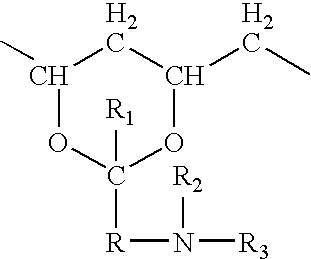Bone substitute
a bone substitute and bone technology, applied in bone implants, medical science, prosthesis, etc., can solve the problems of increasing the risk of compression fracture or collapse, chronic complications, and the inability of cancellous bone to provide interior support for cortical bone, and achieves fast setting in body fluid and adding toughness.
- Summary
- Abstract
- Description
- Claims
- Application Information
AI Technical Summary
Benefits of technology
Problems solved by technology
Method used
Image
Examples
example 1
PVA Hydrogels without Fillers
[0105]Table 1 summarizes the mechanical properties for the different formulations. As shown in Table 1, number 1, the mechanical properties of hydrogel itself (without inorganic filler) are low. The increase in crosslinking density, solid content can only slightly improve the mechanical properties, especially the modulus of the hydrogel system. An increase in crosslinking density or the concentration of DAA can increase the toughness of the hydrogel, but it will still be far from the stiffness and strength of vertebral cancellous bones and not suited for load bearing applications.
example 2
Addition of Fillers
[0106]In order to increase the modulus and strength of the hydrogel system, different calcium salts were explored systematically (see Table 1 samples 2-8). The salts were hydroxyapatite (HA), tricalcium phosphate (TCP), and amorphous calcium phosphate (ACP). The tangent modulus at 1% strain with different types of calcium salts ranges from about 5 to 25 MPa, which is up to 10 times higher than without filler. Calcium salts are very effective at increasing the mechanical properties of the formulations, e.g. the tangent modulus almost doubles when the HA concentration is increased from 49% to 58% (see samples 2 and 3). Despite the increase in tangent modulus, formulations with different calcium salts are surprisingly tough and did not fail when compressed up to 80% strain. The overall data indicates that the microscale HA is more effective in increasing the modulus compared to nanoscale HA. For formulations with calcium salts, the ultimate stresses are listed in Tab...
example 3
Addition of Fillers and Additional Crosslinkers
[0107]These bone cement formulations with different types of calcium salts can match cancellous bones with relatively low mechanical properties. Although further increases in the concentration of calcium salts can further increase the tangent modulus and the strength of the bone substitute, the increase in viscosity due to high concentration of calcium salts will induce additional problems in mixing and delivery for practical application. To overcome this problem, low molecular weight crosslinkers were introduced (Table 1, samples 9 to 18). The introduction of 5 to 10 wt % (2.5 to 13 vol %) crosslinker increased the tangent modulus up to about 370 MPa.
[0108]In general, crosslinkers are more effective in increasing the elastic modulus of the formulations compared to the effect of calcium salts. All bone cement formulations with crosslinkers are more brittle. As shown in Table 1, all samples with additional crosslinkers failed at much low...
PUM
 Login to view more
Login to view more Abstract
Description
Claims
Application Information
 Login to view more
Login to view more - R&D Engineer
- R&D Manager
- IP Professional
- Industry Leading Data Capabilities
- Powerful AI technology
- Patent DNA Extraction
Browse by: Latest US Patents, China's latest patents, Technical Efficacy Thesaurus, Application Domain, Technology Topic.
© 2024 PatSnap. All rights reserved.Legal|Privacy policy|Modern Slavery Act Transparency Statement|Sitemap



